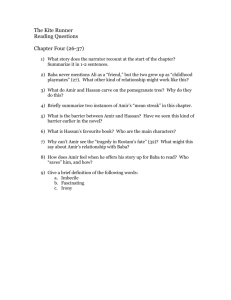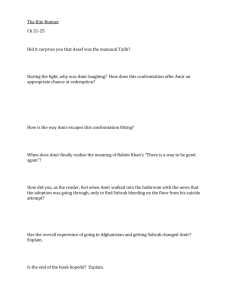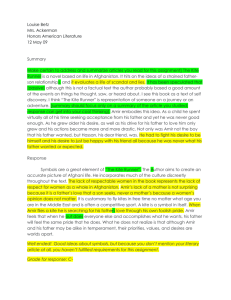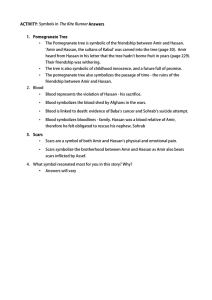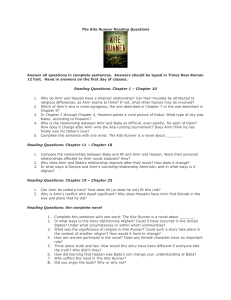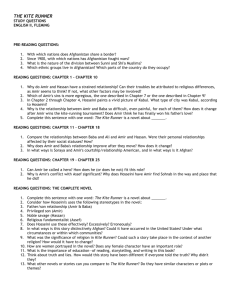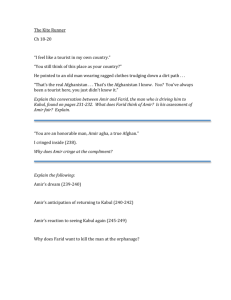The Forbidden Fruit of The Kite Runner
advertisement
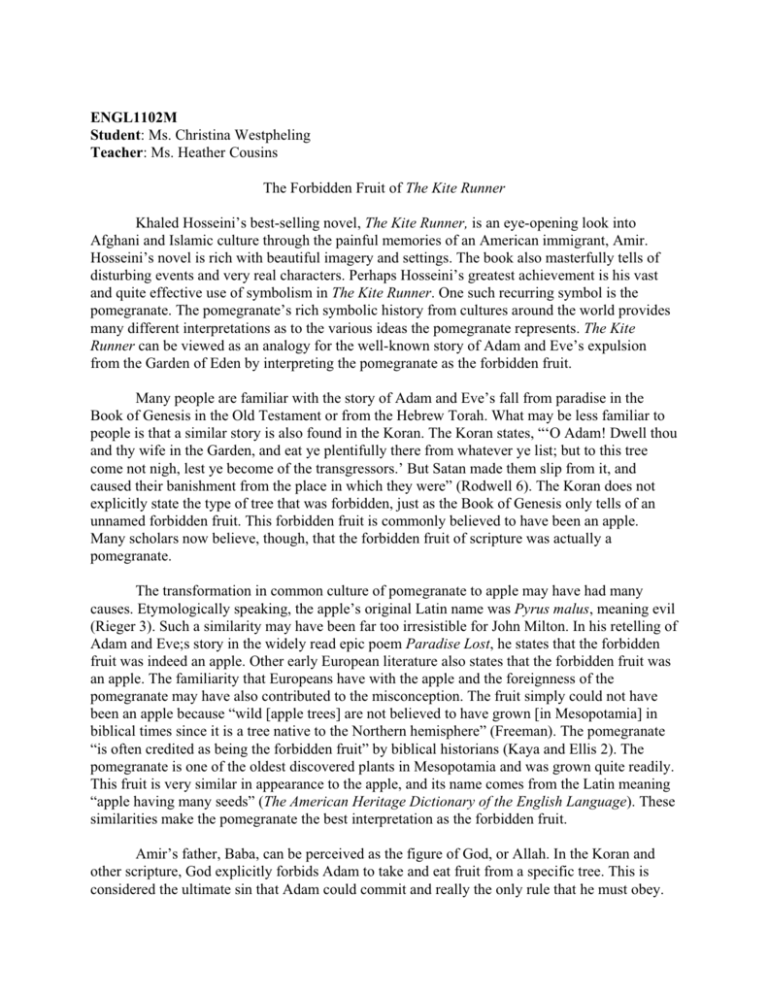
ENGL1102M Student: Ms. Christina Westpheling Teacher: Ms. Heather Cousins The Forbidden Fruit of The Kite Runner Khaled Hosseini’s best-selling novel, The Kite Runner, is an eye-opening look into Afghani and Islamic culture through the painful memories of an American immigrant, Amir. Hosseini’s novel is rich with beautiful imagery and settings. The book also masterfully tells of disturbing events and very real characters. Perhaps Hosseini’s greatest achievement is his vast and quite effective use of symbolism in The Kite Runner. One such recurring symbol is the pomegranate. The pomegranate’s rich symbolic history from cultures around the world provides many different interpretations as to the various ideas the pomegranate represents. The Kite Runner can be viewed as an analogy for the well-known story of Adam and Eve’s expulsion from the Garden of Eden by interpreting the pomegranate as the forbidden fruit. Many people are familiar with the story of Adam and Eve’s fall from paradise in the Book of Genesis in the Old Testament or from the Hebrew Torah. What may be less familiar to people is that a similar story is also found in the Koran. The Koran states, “‘O Adam! Dwell thou and thy wife in the Garden, and eat ye plentifully there from whatever ye list; but to this tree come not nigh, lest ye become of the transgressors.’ But Satan made them slip from it, and caused their banishment from the place in which they were” (Rodwell 6). The Koran does not explicitly state the type of tree that was forbidden, just as the Book of Genesis only tells of an unnamed forbidden fruit. This forbidden fruit is commonly believed to have been an apple. Many scholars now believe, though, that the forbidden fruit of scripture was actually a pomegranate. The transformation in common culture of pomegranate to apple may have had many causes. Etymologically speaking, the apple’s original Latin name was Pyrus malus, meaning evil (Rieger 3). Such a similarity may have been far too irresistible for John Milton. In his retelling of Adam and Eve;s story in the widely read epic poem Paradise Lost, he states that the forbidden fruit was indeed an apple. Other early European literature also states that the forbidden fruit was an apple. The familiarity that Europeans have with the apple and the foreignness of the pomegranate may have also contributed to the misconception. The fruit simply could not have been an apple because “wild [apple trees] are not believed to have grown [in Mesopotamia] in biblical times since it is a tree native to the Northern hemisphere” (Freeman). The pomegranate “is often credited as being the forbidden fruit” by biblical historians (Kaya and Ellis 2). The pomegranate is one of the oldest discovered plants in Mesopotamia and was grown quite readily. This fruit is very similar in appearance to the apple, and its name comes from the Latin meaning “apple having many seeds” (The American Heritage Dictionary of the English Language). These similarities make the pomegranate the best interpretation as the forbidden fruit. Amir’s father, Baba, can be perceived as the figure of God, or Allah. In the Koran and other scripture, God explicitly forbids Adam to take and eat fruit from a specific tree. This is considered the ultimate sin that Adam could commit and really the only rule that he must obey. Like Allah, Baba explicitly tells Amir that the only sin he can commit is theft –– “there is only one sin, only one. And that is theft. Every other sin is a variation of theft . . . There is no act more wretched than stealing, Amir” (Hosseini 17-18). In this analogy, Amir is Adam. Amir led a privileged childhood in Afghanistan, much like Adam in the Garden of Eden. They both wanted for little and were generally happy. They also both possessed a certain degree of power. Amir was in a higher social class than those around him, and Adam was the only man, made in God Himself’s image. Both Adam and Amir had an innocence about them. Adam, naturally, was without sin until he ate of the forbidden fruit, and Amir, as a child, was also without sin. In Islam, there is not a belief in original sin; Islamic children are born completely innocent and are not made to pay for the sins of their parents (Chauri). Adam and Amir both commit the sin of theft, however, which leads to their expulsion from their paradises. Afghanistan was Amir’s and his father’s Garden of Eden. The country is described as a paradise during Amir’s childhood. Amir described his house as gorgeous — “everyone agreed that my father, my baba, had built the most beautiful house . . . Some thought it was the prettiest house in all of Kabul” (Hosseini 4). His home was completed by a lush two-acre garden that was the playground for Amir and his childhood friend and half-brother, Hassan (Hosseini 5). The various picturesque scenes that Hosseini presents his readers with of pre-Taliban Afghanistan really show Amir’s homeland as a paradise. Amir is eventually forced by his father to leave such a paradise for a place that is not perceived as beautiful and pure as the Afghanistan of Amir’s youth, America. America is seen by Amir and his father, particularly, as not as wonderful as Afghanistan: “smog stung [Baba’s] eyes, the traffic gave him headaches, and the pollen made him cough. The fruit was never sweet enough, the water never clean enough, and where were all the trees and open fields?” (Hosseini 126). The greatest sin in The Kite Runner was the rape of Amir’s friend and half-brother, Hassan, by a neighborhood bully. Rape is a form of theft; its name actually comes from the Latin for theft, rapio (The American Heritage Dictionary of the English Language, 4th Edition). Amir, though he does not actually commit the rape, does nothing to prevent if from happening. This is similar to Adam. He is not the first to eat the forbidden fruit, but he does not stop his wife from doing so. He eventually even eats the fruit himself (Rodwell 97). Hassan’s rape is graphically described and filled with images of blood (Hosseini 77-78). This bloody imagery reappears in the scene in which Amir pelts Hassan with pomegranates: “I don’t know how many times I hit him. All I know is that when I finally stopped, exhausted and panting, Hassan was smeared in red like he’d been shot by a firing squad. I fell to my knees, tired, spent, frustrated” (Hosseini 92-93). This violent, heart-wrenching scene almost relives Hassan’s rape. This time, Amir is raping Hassan with his violent domination, and Hassan’s lamb-like submission is disturbingly similar to his reaction to his actual rape. The idea of the rape being the ultimate sin and ultimate theft is further reinforced by the presence of the forbidden fruit, the pomegranate. The Kite Runner is a beautifully told story of terrible events. The success of the story lies in its ability to reconcile these horrors with very real characters. Amir is a very flawed human, but through the story of Adam’s expulsion from Eden, these flaws are easier to comprehend. The immense symbolism that Hosseini uses makes this analogy able to be made. This symbolism is also what makes this story universal. It makes a story of Afghani culture quite relevant and accessible to an American audience. Through the commonness of human flaws and sin, Americans are able to identify with an Afghani culture that appears to be radically different from American culture. The American reader is able to discover a great sense of humanity in this novel, and also a sense of kinship with characters. Perhaps the two cultures are not so different. After all, both the Koran and the Bible state that all humans are not so different, and both the Koran and the Bible state that all humans are the descendants of Adam. Maybe the realization that both peoples come from the same place will prompt actions that will lead both countries toward a better future and paradises of their own. Works Cited Freedman, David Noel. The Anchor Bible Dictionary: Volume 2. New York: Bantam Doubleday Dell Publishing Group, Inc., 1991. Ghauri, Abdus Sattar. “The Concept of Original Sin.” 13 November 2002. Understanding Islam. 23 February 2008 <http://www.understandingislam.com/related/text.asp?type=article&aid=178#_ftn2>. Hosseini, Khaled. The Kite Runner. New York: Penguin, 2003. Prpic, J. Kaya, and Ainslie E. Ellis. “Influences in the design of a faculty-wide tutor development program.” HERDSA, 2002. Rieger, Mark. Introduction to Fruit Crops. Birmingham: Food Products Press, n.d. Rodwell, J. M. The Koran. London: Orion Publishing Group Ltd, Orion House, 1909, 1992, 1994. The American Heritage Dictionary of the English Language. 4th edition. Houghton Mifflin, 2006.
